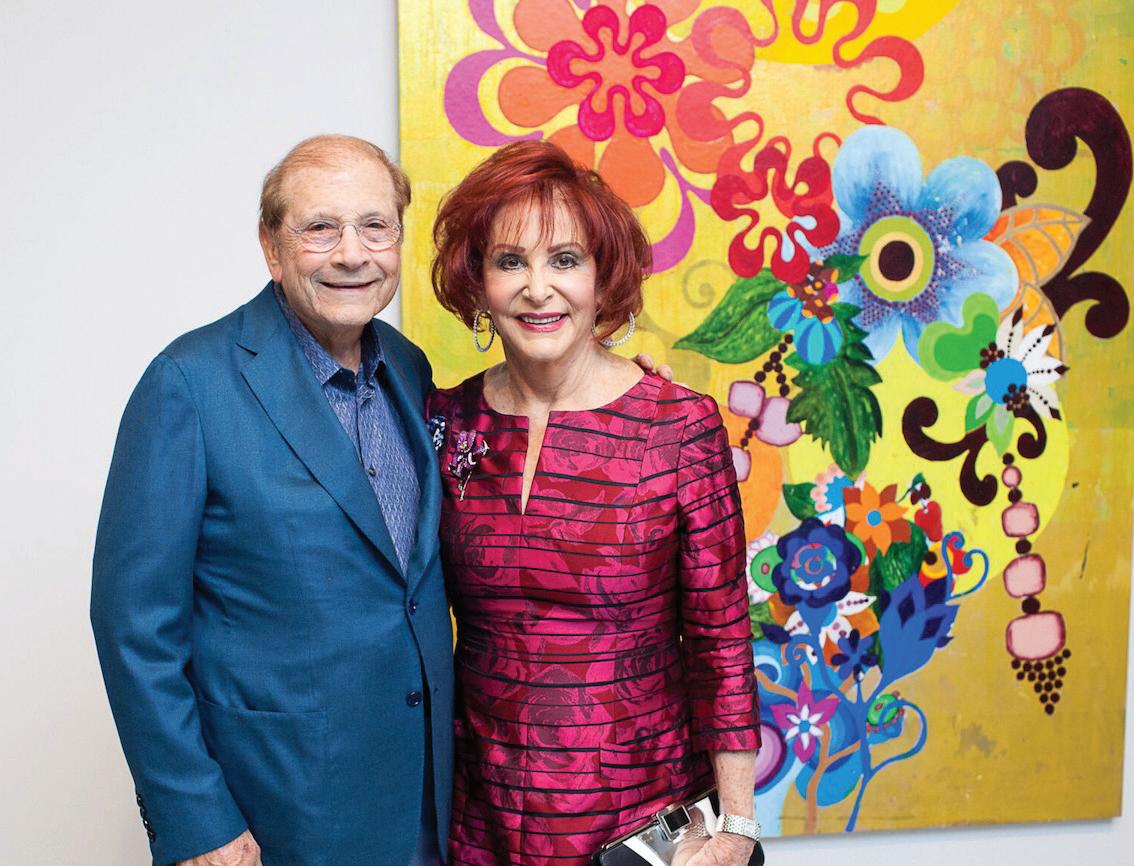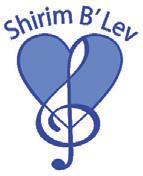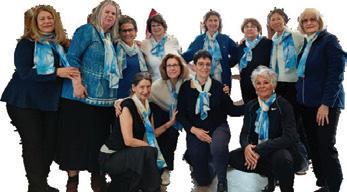










PUBLISHERS
Diane Benaroya & Laurie Miller
EDITOR-IN-CHIEF
Alanna Maya
CREATIVE DIRECTOR
Laurie Miller
CONTRIBUTORS
Ariela Alush, Barbara Birenbaum, Franklin Felber, Donald H. Harrison, Jacob Kamaras, Stephanie Lewis, Salomon Maya, Jana Mazurkiewicz Meisarosh, Terra Paley, Mimi Pollack, Rachel Stern, Eva Trieger, Deborah Vietor, Chana Jenny Weisberg, Cheri Weiss
ADVERTISING & SALES
Diane Benaroya: dianeb@lchaimmagazine.com



L’CHAIM SAN DIEGO, LLC (858) 776-0550 P.O. Box 27876, San Diego, CA 92198
EDITORIAL editor@lchaimmagazine.com
ADVERTISING dianeb@lchaimmagazine.com
lauriem@lchaimmagazine.com
LISTINGS
Copyright ©2025 L’Chaim San Diego LLC. All rights reserved. No part of this publication may be reproduced, distributed or transmitted in any form or by any means, including photocopying, recording, or other electronic or mechanical methods, without the prior written permission of the publisher, except in the case of brief quotations embodied in critical reviews and certain other noncommercial uses permitted by copyright law. For permission requests, write to the publisher, addressed “Attention: Permissions Coordinator” to: publisher@lchaimmagazine.com
Published in San Diego, CA • www.lchaimmagazine.com

This may be a particularly challenging Passover for Jews around the world to celebrate. On this holiday — the most popular one in the Jewish calendar — we retell the story of our ancestors’ escape from Egyptian bondage into freedom. We gather with our families and friends around the Seder table. We bless God, who has provided us with the good fortune to eat matzah, maror, charoset, karpas, and other symbolic ritual foods, along with the rest of our festive meal. We drink four glasses of wine or grape juice (again blessing God). We kvell as our children chant the Four Questions, beginning each question with, “Mah nishtana halaila hazeh mi-kol haleilot?” (“Why is this night different from all other nights?”). And we jubilantly sing songs such as Echad Mi Yodea (Who Knows One), Dayenu (It Would Have Been Enough) and Chad Gadya (One Little Goat).
Yet in the midst of our joy, how can we not feel sadness for those who are still suffering halfway across the globe? Many of the Israeli hostages remain in captivity more than a year and a half post-capture. Too many lives have been lost in this horrible, protracted war for us to ignore. So, is it still acceptable for us to find joy in Passover while so many others
suffer?
In the Yad Vashem Holocaust Museum archives, there is a webpage dedicated to a photo display of Jews observing Passover during World War II: yadvashem.org/yv/ en/exhibitions/passover/index.asp. On this webpage, we can see photos depicting a Passover Seder in a Polish hospital in 1941; Jews celebrating the holiday in the Warsaw Ghetto; baking matzah in hiding in Lodz, Poland in 1943, in France in 1943, in Hungary in 1944; a Seder for Jewish Allied soldiers.
It seems almost incomprehensible that in many of these photos, people are smiling as they look into the camera. In the middle of The Holocaust — the most tragic period in Jewish history people found ways to celebrate Passover and continue its traditions. Perhaps it was in defiance of their circumstances that they were determined to honor their heritage and the Torah commandment to retell the story of our people’s liberation from oppression and bondage to their children and each other: “And you shall tell your child on that day, ‘It is because of what God did for me when I went free from Egypt.’ ” (Exodus 13:8)
Perhaps we can find meaningful ways to
remember those who are still in captivity and/ or grieving their losses by incorporating some new symbols or rituals into our Seder this year. Consider setting a special, unoccupied place at your Seder table to acknowledge the not-yet-released hostages and observe a minute of silence. During the reading of the ten plagues, we dip our finger into the wine or juice to remove a drop from our cups for each plague, signifying a decrease in our joy to recognize the suffering of the Egyptians during this time. Perhaps at our Seder this year, we can dip our finger yet once more, in solidarity with our people still suffering the plague of prolonged captivity.
You may also find or develop other meaningful rituals at your Seder that acknowledge the Israeli hostages still being held in Gaza. While these may be simply symbolic gestures, it is incumbent upon us to keep these hostages in our hearts and prayers this Passover. May we, our children, and future generations of Jews continue telling the story of our people’s liberation from oppression and bondage for generations to come.
RABBI-CANTOR CHERI WEISS IS THE SPIRITUAL LEADER OF TEMPLE EMANUEL IN HONOLULU, HAWAII.




As artificial intelligence reshapes global communications, Israeli and Jewish tech innovators and organizations are developing new AI-powered tools to counter misinformation and antisemitism online while working to ensure an accurate representation of Israel in digital spaces.
“AI is the next step in the technological advancement of human information consumption,” said Yana Indy Greenman, a former VP for Strategy and Policy at Israel’s Ministry of Energy and Infrastructure. “As we have seen with Google, Wikipedia, and social media, if we don’t want it to be weaponized against us, we must get involved in safeguarding it and creating positive AI tools for the future before our enemies do so.”
Greenman, who grew up in the Former Soviet Union, is a granddaughter of Holocaust survivors and currently resides in Dunedin, New Zealand. She said that there is an urgency in addressing this challenge: “Most people don’t know that Israel is a democratic country. For decades they have received the message that Israel is a radical colonizer. Now it is almost impossible to change a person’s mind once they believe in something. I know. I grew up in a society that used brainwashing all too well.”
According to Greenman, Israelis are naive about what the world has undergone in the past 20 to 30 years. “There has been an incredible amount of anti-Israel messaging out there and we simply have no idea the extent of it. We cannot allow what happened with the weaponization of social media and Wikipedia, to take place again with AI,” she said.
Several organizations are developing AI solutions to address these challenges each in their own way. Shiran Mlamdovsky Somech, a tech industry veteran and founder of Generative AI for Good, organized “Hack the Hate,” a major conference held on Sept. 10, 2023, at Microsoft’s Tel Aviv offices in partnership with the Unit 8200 Alumni Association that addressed online hate speech and antisemitism.
“The hate speech and antisemitism is like David versus Goliath,” Mlamdovsky Somech said. “We are only 15 million Jews around the world, versus 2 billion Muslims, not counting far-right groups and other forms of antisemitism. Our slingshot is technology.”
One significant initiative called “Bottom Line,” founded by Ariella Noveck and former IDF Spokesperson Jonathan Conricus, has developed an AI chatbot providing journalists with reliable, real-time information about Middle East events.
“Our AI bot ensures that information provided is reliable by sourcing and citing verified data in real-time,” Noveck explained. “It allows journalists to ask specific, timely questions about world events as they happen, and if the bot doesn’t have the answer, it immediately pings a Bottom Line expert to provide verified information.”
Noveck emphasized the importance of proactive education rather than reactive criticism: “It’s always better to address misinformation proactively and prevent it from happening in the first place, rather than simply reacting with online comments, op-eds, or criticism. Often, if we attack journalists we will lose them in the future. It is difficult to hold a journalist accountable for misrepresenting a story when all the source material they have is slanted in one direction. By educating journalists, and providing them with reliable, factual, and unbiased source information, we can alleviate the problem of the negative headline before it even happens, and gain the goodwill of the journalist for the future.”
Another significant development is Reasonate, created by Ariel Halevi’s company, Vayomar. The platform uses AI to help users construct effective responses to anti-Israeli statements online.
“Instead of training people, I could train an agent, but that isn’t the ideal. People are looking for connection” Halevi said. “So we are providing people with an assisted conversational tool that gives them immediate information and tactics of how to respond, not just what to say, but psychological tactics to deescalate an online confrontation and actually get the other person you are interacting with to listen.”
Halevi said that his system, although fully developed, is in its fledgling state of use. He said it is similar to Grammarly in that it can sit on the browser of a user and highlight any anti-Israeli statement that the user has a problem addressing. “Reasonate would then automatically generate a response based on the principles of persuasion that it has been developed with, which are a cumulation of more than two decades of

experience we have built up at Vayomar,” he explained.
Mlamdovsky Somech highlighted another critical challenge: the need to digitize historical archives to ensure accurate AI training data.
“We have very impressive archives like Yad Vashem, but most of the data is not digitized,” she said. “This makes it difficult for AI large language models (LLMs) to access accurate information about historical events. We have situations happening where AI is already coming up with potential profiles of Holocaust survivors but the information being given over is completely inaccurate. It is urgent that we digitize historical archives that can help train and preserve important historical information, and add it to the AI datasets before it becomes erased, lost, or fabricated.”
Other new initiatives include the Facts Commando project by Boaz Drei, which developed a system allowing thousands of volunteers to share pro-Israel content across social media platforms efficiently, and Atchalta, founded by Eran Shayshon, which uses AI and mind mapping technologies and combines it with their own specially developed methodology to develop new approaches to combating antisemitism for organizations by emphasizing a cohesive and comprehensive approach to change the ecosystem in which antisemitism thrives.
One thing that all of the founders of these initiatives agree upon is that beyond developing new AI technologies, the most important aspect of combating antisemitism in person or online and changing the narrative of anti-Israel sentiment is to build and create a united front among the Jewish and pro-Israel community.
“We need to be working together, only by creating a united front, it doesn’t have to be unified, but it has to be united, can we change the current narrative and flip the script on antisemitism and anti-Israel sentiment,” Shayshon added.
Mlamdovsky Somech and Greenman both said that education plays a huge role in helping people become more moderate or even proIsrael and against antisemitism. “It’s really a question of education,” Mlamdovsky Somech said. “AI can help us mold the narrative and keep the narrative unbiased, but the long-term solution is education. We need to be more hands-on and make the truth more accessible to the children in schools and students on campuses worldwide. We need to fight ignorance. We can do that somewhat via social media, but we cannot limit ourselves to fighting only there. In the long term, we need to work within the education system where opinions are developed in the first place.”
The success of AI initiatives such as these will play a crucial role in any future discourse about Israel and in slowing down or stopping the wave of antisemitism. As AI is used more and more as the main source of online information, it is rapidly becoming the next location where public opinion and narrative are created and developed.
Greenman warned: “In a few years, once all of the data gets uploaded from the information war that started on October 7th, AI systems might present a distorted view of Israel. That will shape minds and opinions for the future, and that is what we need to avoid long-term from happening.”



1. Which of these famous composers was not Jewish?
a. Leonard Bernstein
b. George Gershwin
c. Richard Wagner
d. Felix Mendelssohn
2. Which is the only ritual mentioned explicitly in the Ten Commandments?
a. Keep Shabbat
b. Eat kosher
c. Pray every day
d. Give tzedakah (charity)
3. Which Jewish woman was instrumental in discovering the double-helix model of DNA, but was not given a share of the Nobel Prize won by James Watson and Francis Crick?
a. Marie Curie
b. Rosalind Franklin
c. Lise Meitner
d. Vera Rubin
4. Which Jewish woman was instrumental in discovering nuclear fission, but was not given a share of the Nobel Prize won by her long-time collaborator Otto Hahn?
a. Marie Curie
b. Rosalind Franklin
c. Lise Meitner
d. Vera Rubin
5. Who divided the Torah into chapters?
a. Yehuda HaNasi
b. Hillel the Elder
c. Maimonides
d. The Archbishop of Canterbury
6. Of the twelve tribes of Israel, how many were “lost” when the Jews of the northern kingdom of Israel were deported by the Assyrians in
722 B.C.E.?
a. 4
b. 6
c. 8
d. 10
7. According to a 2003 European Union survey, what was the rank of Israel among countries threatening world peace?
a. Number 1
b. Number 6
c. Number 11
d. Number 16
8. When does a Jewish woman traditionally purify herself in a mikvah?
a. Before her wedding
b. After her menstrual period, before resuming marital relations
c. After giving birth
d. All of the above
9. Which Jew was the “junkbond king” in the 1980’s, earning more in one year than McDonald’s Corporation?
a. Ivan Boesky
b. Michael Milken
c. Carl Icahn
d. Gordon Gekko
10. According to the Talmud, women are created with what quality greater than men?
a. Physical attractiveness
b. Ability to love
c. Resilience
d. Powers of understanding
Answers on page 19.
©2025 Felber, Starmark, Inc., all rights reserved.

A Tribute to Matthew C. Strauss Provides a Public Glimpse into the Private Collection of Iris and Matthew Strauss
Last year, San Diego lost a dedicated businessman, family man, arts lover and philanthropist, Matthew C. Strauss. Together with his beloved wife of 70 years, Iris, Matthew Strauss made a collective mark on arts and culture, cancer research, and the Jewish community in San Diego. Now, selections from their private art collection, repeatedly highlighted in ARTnews Top 200 Collectors list, will be on display at the Museum of Contemporary Art San Diego (MCASD) in La Jolla. An Artful Life: A Tribute to Matthew C. Strauss honors the philanthropic legacy of this San Diego native by showcasing two dozen artworks for a limited-time special exhibition. From artists associated with Pop Art to today’s brightest talents, the exhibition shows the variety and dynamism of recent art.
Visitors to MCASD, located on the coastal bluffs of La Jolla, will be able to experience the vibrancy of contemporary art, as seen through the eyes of this impassioned art collector and generous philanthropist. An Artful Life: A Tribute to Matthew C. Strauss provides a public glimpse into the private collection which is recognized for its bold and expansive holdings of contemporary art. For more than 35 years, the couple built a collection that features art world luminaries. In the late 1980s, the Strausses began collecting in earnest. They began by looking. The Strausses decided to focus their attention on the art of the present day–contemporary art. The couple frequented galleries and visited museums, particularly the Museum of Contemporary Art San Diego. At MCASD they were introduced to artists, like Jennifer Bartlett, whose work would become some of their earliest purchases. They also traveled with MCASD’s patrons’ circle, where they were able to meet other collectors as well as artists. Matthew Strauss felt their collection made one look at art differently, by offering new perspectives of the world around us.
Through such research, travel, and intuition, Matthew and Iris shaped a collection that highlights developments in painting from the past four decades. The featured artists in An Artful Life, likewise, span generations: from figures who emerged on the American art scene in the 1960s, such as Robert Rauschenberg and Alex Katz, to younger talents, such as Damien Hirst and Mickalene Thomas and who were born in the 1960s. Abstract works by Frank Stella and Elizabeth Murray–part sculpture, part painting–seem to emerge from the gallery wall, while lush canvases by Cecily Brown and Kehinde Wiley update the
Through such research, travel, and intuition, Matthew and Iris Strauss shaped a collection that highlights developments in painting from the past four decades.
tradition of figurative painting. The collection also reflects the international character of today’s art world. An Artful Life contains paintings by Sigmar Polke and Georg Baselitz, both who were active in Germany. Other global highlights include a signature “happy flower” painting by Japanese art star, Takashi Murakami, and a gold-backed floral composition by Beatriz Milhazes from Brazil. The exhibition also includes two distinctive, figurative sculptures. Antony Gormely creates a lead-covered figure that appears to be falling. The noted British artist often uses his own body as the basis for his work. Nick Cave creates mixed-media “sound suits,” which are intended to be worn in dancelike performances. Here, colorful crocheted squares form a fitted garment that is adorned with an outsized floral headpiece.
As the Strauss collection grew in scale and importance, so did their leadership in the arts community. Iris served on the San Diego Arts Commission. Matthew held leadership positions at MCASD, serving as a Trustee since 1991. As President from 2013-2016, he helped initiate the goal to expand the La Jolla

location, spearheaded by Selldorf Architects. This project changed the face of the Museum forever, quadrupling the size of the existing gallery space to bring MCASD’s incredible permanent collection holdings to the public. It’s fitting that the upcoming exhibition will be displayed in the Iris and Matthew Strauss Galleries at the newly remodeled La Jolla location.
“My parents were passionate about art and their goal was to collect the best examples of contemporary art from the best artists, which is how they created a World Top 200 collection,” said Steve Strauss, MCASD Board President. “They also accepted the responsibility for being custodians of this art collection which they shared and exhibited with the public, including local art institutions, museums, colleges and universities.”
“Matthew and Iris Strauss’ generosity has bolstered MCASD’s
vision to connect diverse audiences to the transformative power of art,” explained Kathryn Kanjo, The David C. Copley Director and CEO. “This small slice of their impressive collection is a window into a life devoted to contemporary art at the highest level. It’s fitting that these works will be on display in the Strauss Galleries, named in their honor, in our expanded La Jolla facility. We hope it inspires the next generation of art collectors.”
JOAN AND IRWIN JACOBS ARE PRESENTING SPONSORS OF AN ARTFUL LIFE, ALONGSIDE OTHER SPONSORS INCLUDING BARBARA ARLEDGE, SHELDON MORRIS AND CATRIONA JAMEISON. LEARN MORE AND PLAN YOUR VISIT AT HTTPS:// MCASD.ORG.


BY TAMAR ROTHENBERG, MS, RDN, AUTHOR: CANCER DIET FOR THE NEWLY-DIAGNOSED
Move aside, brisket, and let’s make room for a light and refreshing Passover dish. This recipe features warm grilled fish paired with a citrusy and tangy salsa, making it ideal for entertaining and visually stunning.
This recipe is great because the varieties are endless. You can choose other fish, such as baked cod or flounder, or grilled tuna and halibut. Don’t have mango, or is someone allergic? No problem! You can easily substitute peaches, pineapple, or papaya for a similar sweetness. This flexibility not only accommodates dietary preferences but also allows you to experiment with flavors, ensuring every meal is unique and delightful.
I hope this recipe becomes a Passover staple for your family!
Grilled Salmon with Mango Salsa
Prep Time: 20 mins
Total Time: 30 mins
Makes 4 servings
INGREDIENTS
For the Salmon
1 1/2 lbs. salmon
2 Tbs olive oil
Salt, black pepper, to taste
For the Salsa
2 cups mango, chopped
1/2 cup tomato, chopped
1/2 bell pepper, red, chopped
1/4 cup scallions, minced
1/2 tsp jalapeño pepper, minced
1 lime, juiced
3 Tbs cilantro, fresh, chopped
Salt, to taste
DIRECTIONS
1. Make the salsa: dice the mango, tomato, and bell pepper; mince scallions and jalapeño; juice lime and finely chop cilantro. Mix all ingredients in a bowl and season with salt. Set aside.
2. Heat grill to medium-high heat, or use a grill pan.
3. Divide salmon into 4 equal filets with skin on.
4. Brush each salmon fillet with 1/2 tablespoon of olive oil sprinkle with salt and pepper to taste.
5. Place on the grill, skin side up first (flesh side should be grilled first to avoid early separation from skin). Grill salmon until firm and browned, about 4 minutes per side.
6. Transfer salmon to a serving platter.
7. Spoon salsa over warm salmon filets just before serving.
Tamar Rothenberg, MS, RDN, is a registered dietitian who specializes in breast and ovarian cancer in her private practice in Los Angeles. She has a Certificate of Training in Vegetarian Nutrition and Herbal Formulations in Cancer Care; and co-led the clinical study, Coping with Cancer in the Kitchen, published in Nutrients. Tamar lends her expertise to Sharsheret Thrivers through nutrition coaching. Check out Tamar’s other recipes in her book, Cancer Diet for the Newly Diagnosed: An Integrative Guide and Cookbook for Treatment and Recovery. Visit Tamar’s website at https://www.tamarrothenbergrd.com/ for more information.
THIS RECIPE WAS SUBMITTED BY THE NON-PROFIT ORGANIZATION, SHARSHERET, THE JEWISH BREAST CANCER AND OVARIAN CANCER COMMUNITY. IF YOU OR SOMEONE YOU LOVE HAS BEEN IMPACTED BY BREAST OR OVARIAN CANCER OR HAS ELEVATED GENETIC RISK, CONTACT SHARSHERET FOR FREE SUPPORT AND RESOURCES. FOR MORE INFORMATION, VISIT SHARSHERET.ORG OR CALL (866) 474-2774.

When the Seacrest community decided to renovate 40 of their assisted living apartments, they wanted to make it as easy as possible for their residents. Silver Linings Transitions was hired to work with the clients, pack up their apartments for the renovation and then move each client back in recreating the feeling of home.
Before founding Silver Linings Transitions, Jami Shapiro spent a decade as a Realtor, guiding clients through buying and selling homes—even during the height of the foreclosure crisis. Yet, something was missing. The work felt transactional, rather than meaningful.
A cancer diagnosis and her grandmother’s sudden passing caused things to change. Her family was left sorting through decades of belongings while grieving—a daunting process that many families face without adequate support. This experience, combined with her professional observations, inspired her to explore a new way to assist people during major life changes.
In 2014, she discovered the National Association of Senior Move Managers (NASMM). It was a revelation. Here was an organization dedicated to providing the very service she felt called to offer— helping seniors and others transition to new homes with care and organization.
Silver Linings Transitions does much more than pack boxes. Their services are designed to provide both practical and emotional support, including:
1. Personalized move management to create a smooth, stress-free transition
2. Home consultation services with free services provided through a referral program
3. Home organizing for those feeling overwhelmed by clutter
4. Paperwork organization to simplify financial and legal matters
5. Photo organizing to preserve cherished memories
6. Senior advisory services to help families navigate aging options
As a Certified Senior Move Manager and Certified Senior Advisor, Jami believes in an educational approach empowering families to make informed decisions. They provide resources, connections, and personalized guidance to ensure our clients feel in control of their next steps.
Through years of working with seniors, Jami noticed a common struggle with chronic disorganization. It soon became clear that many of these individuals had undiagnosed ADHD—something she related to personally. Jami and several family members have been recently diagnosed.
ADHD doesn’t disappear with age, yet it remains widely undiagnosed in older generations. This realization led Jami to become a Specialist in ADHD and launch the Grandma Has ADHD podcast and platform to raise awareness about the intersection of aging and neurodiversity. Understanding these unique challenges allows us to implement organizing strategies that truly work for neurodivergent clients.
Silver Linings Transitions is about more than serving clients—it’s about creating opportunities. After her 15-year marriage ended, she experienced firsthand the struggles women face when re-entering the workforce. That’s why Silver Linings Transitions supports people who
are rebuilding their careers, offering meaningful employment in an environment that values flexibility, growth, and community. As a single mother of three, Jami understands the importance of balancing work and family. Her team is a home for those who need a fresh start, just as she helps clients create new beginnings in their own lives.
Jami’s deep connection to Judaism and involvement with organizations like B’nai B’rith and Hadassah have instilled the values of compassion, leadership, and community service. These principles shape Silver Linings Transitions, ensuring she approaches every client with respect, empathy, and a commitment to making life’s changes as smooth as possible.
What sets her apart is her dedication to making every move feel seamless—even joyful. From creating floor plans to unpacking and setting up new homes, she handles the details so our clients can focus on settling into their next chapter with ease. Sorting through possessions often brings moments of reflection and rediscovery. She creates space for those meaningful experiences while keeping the move on track. Her commitment to excellence has earned us five-star ratings across Yelp, Google, and Facebook, as well as A+ Accreditation from NASMM.
Twenty years after her cancer diagnosis, Jami continues to believe in finding silver linings in life’s challenges. Silver Linings Transitions helps others do the same. Whether you’re downsizing after decades in one home, starting fresh after a major life change, or simply feeling overwhelmed by clutter, she's here to guide you with care and expertise.

1. c. Wagner was an antisemite.
2. a. The Fourth Commandment is, “Remember the Sabbath Day to keep it holy.”
3. b. Rosalind Franklin used x-ray crystallography to reveal the helical structure of DNA, crucial evidence that allowed James Watson and Francis Crick to finalize their double-helix model of DNA.
4. c. Lise Meitner was nominated 19 times for the Nobel Prize in Chemistry and 30 times for the Nobel Prize in Physics. Einstein praised her as the “German Marie Curie.” She was the first woman to become a full professor of physics in Germany. She lost her position in 1935 because of the Nuremburg Laws of Nazi Germany and fled to the Netherlands in 1938.
5. d. Stephen Langton, Archbishop of Canterbury in the 13th century, divided the Bible into chapters to facilitate bible study and make it easier to recall sources of verses. His arrangement of chapters remains in use today.
6. d. From Assyria, now northern Syria, Iraq and Iran, the ten “lost” tribes, all but Judah and Benjamin, were dispersed to areas that are now in India, Pakistan, Afghanistan, Ethiopia, and even northern Europe, according to research, customs, and legends.
7. a. Move over Russia and China, Iran and North Korea. Israel was selected as the number one country threatening world peace.
8. d. A Jewish woman traditionally immerses herself in a mikvah under all these circumstances.
9. b. In the late 1980s, Milken earned a U.S. record $1 billion over four years as head of the high-yield bond department at Drexel Burnham Lambert. He served two years of a ten-year sentence for securities violations. Gekko’s line, “Greed is good,” in the 1987 movie, “Wall Street,” was adapted from a remark by arbitrageur Boesky, who was later convicted for insider trading.
10. d. Women have greater powers of understanding, “binah yeserah,” according to Tractate Niddah, 45b. Some interpretations teach that women are inherently more intelligent. Others teach that women reach adult mental maturity earlier than men because men tend to gain wisdom from their environment, which takes more time.
0 – 2 Talmid/Talmida (Student)
3 – 5 Melamed/Melamedet (Teacher)
6 – 8
Talmid Chacham/Talmidat Chacham (Scholar)
9 – 10 Gaon/Gaona (Genius)
Your comments are welcome at Felber@Jewish-IQ.com
©2025 Felber, Starmark, Inc., all rights reserved.







Amy and Jordan Moss’s path to becoming top Realtors in San Diego is a testament to their hard work, passion, and commitment to helping others. The Moss family’s journey began with a vacation to visit San Diego and Legoland in Carlsbad, California. What started as a fun getaway soon turned into a lifechanging moment. They fell in love with the San Diego coastline— the breathtaking landscapes and the beachside lifestyle they had always dreamed of.
The thought of leaving Michigan winters behind and moving closer to family in California was an easy decision. Shortly after their visit, the Moss family made a bold choice—they sold their home and relocated their family and successful real estate business across the country to San Diego.
They built onto their real estate business and transitioned to selling properties in communities across San Diego. After a couple of short years of helping their clients buy and sell luxury properties, they were able to realize their dream and purchase their own home. For them, it was a moment of destiny—”beshert,” a Hebrew term meaning “meant to be.”
Rooted in Jewish values, Amy and Jordan have built a reputation for excellence here in San Diego. They are known for their integrity, personalized service, and profound commitment to their clients. Recently, their outstanding achievements in the real estate industry earned them the prestigious Coldwell Banker International Diamond Society award, the NSDCR R.E.A.L. award for the Top 10% of Realtors in San Diego, and they recently earned the CLHMS Guild
designation. This
is a reflection of their expertise, passion, and relentless drive to ensure the best possible outcomes for their clients.
Amy and Jordan are not just committed to excellence in real estate—they are also deeply passionate about supporting their Jewish community. Raising their children with Jewish values has always been at the heart of their family’s journey. In today’s world, where antisemitism continues to be a challenge, they believe in the importance of standing together and supporting fellow Jewish families. Helping Jewish families find their place in San Diego is core to their business and values. Amy and Jordan understand the importance of creating a sense of belonging, especially in a time when community support is more essential than ever.
When you work with the Moss team, you’re partnering with realtors who understand the local real estate market, the importance of family, and the value of a truly exceptional lifestyle. They offer a wealth of knowledge of the San Diego’s finest properties and best-kept secrets. Whether you’re downsizing and selling your home, relocating to San Diego or you’re looking to find a home where you can make Shana Tovah memories, Amy and Jordan Moss are the mensch team you want by your side.
“This Passover, may you find freedom in new beginnings, strength in overcoming challenges, and joy in the company of loved ones. Chag Pesach Sameach!”
- The Moss Team


BY MIRIAM GERSHENSON

Along with holding a garage sale to get rid of her chametz over Pesach, Stephanie promised her family (particularly her longsuffering mother-oy!) a hiatus from being the subject matter of her humor. Her regular column will return next month, but meanwhile we delve into the meshuganah mind of the maven who creates mirth and mayhem for Mazel and Mishagoss!
For the past ten years, Stephanie Lewis has been a fixture in L’CHAIM Magazine, bringing humor to the community with her witty and sharp column Mazel & Mishagoss. But her journey as a writer didn’t start there. In fact, it began much earlier—with a handmade neighborhood magazine called The Stephanie Scribbler that she created as a child, slipping handmade copies under the doormats of every neighbor on the block.
Writing was always her way of standing out. With an athletic brother who garnered all their father’s praise, Stephanie found her own way to shine through words. A simple rhyming assignment in fourth grade caught the attention of her teacher, sparking a lifelong love of writing. That love ultimately led her to major in English with an emphasis in writing, a foundation that would serve her well in the years to come.
Her humor has graced the pages of The Huffington Post and Jewlarious, Aish HaTorah’s digital platform. As a mother of six (ages 21 to 34), her children often find themselves the unwitting stars of her columns—much to their annoyance. Her mother, now in her 80s, also makes regular appearances in her writing, proving that no family member is safe from her comedic observations.
While humor is her forte, Stephanie’s storytelling extends to the stage as well. She’s an accomplished playwright who has been entering (and winning) playwriting contests since COVID. Her first competition, in Carlsbad, centered on the theme of isolation, but it was in Lake Tahoe, Nevada, where she claimed victory. The challenge: write a 10-minute play that includes a horn honking sound. Her winning entry, A Loaded Question, unfolded in a marriage counselor’s office, where a couple with small children clashed over the husband’s gun ownership. The play’s shocking conclusion—where the mother turns
the gun on the father before the lights cut to black and a gunshot rings out—earned it the audience favorite award.
Another notable 10-minute play of hers took a lighter tone. Written for a JCC contest, it followed two non-Jewish women working in Hallmark’s Jewish holiday card department, hilariously bungling the holidays until a rabbi finally shut down their operation. Her collection of 10-minute plays, aptly titled Twisted, became a success off-off-Broadway in New York, thanks to its signature twist endings.
More recently, Stephanie has expanded into musicals. Her first show features a structured Act 1 followed by an improv-driven Act 2, where audiences vote on the storyline’s continuation—a format that has sold out performances in Nevada. She’s currently working on a second musical about female friendships, humorously exploring the spectrum from sisterhood to “mean girls.” The show’s characters— women singing in yoga studios, hair salons, and restaurants— highlight relatable personalities, from the gossip to the woman with no filter. As with her previous work, the audience will decide how Act 2 unfolds.
Beyond publishing and theater, Stephanie is also a novelist. Her book, Lullabies and Alibis, tells the true story of a woman desperate to have a daughter after a life surrounded by boys. The novel is available on Amazon for those looking to dive into her longer-form storytelling.
Stephanie’s greatest supporter in writing was her father, who passed away 20 years ago. Before his passing, he left her an inheritance to be used for a passion project. Honoring his memory, Stephanie has dedicated all ticket sales from her productions to supporting theaters and the arts. In doing so, she ensures that her father’s legacy lives on—not just in the words she writes but in the creative spaces she helps sustain.
With an impressive career including humor columns, awardwinning plays, musicals, and a novel, Stephanie’s storytelling continues to evolve. And if her track record is any indication, she has plenty more stories—filled with laughter, twists, and heart—to share with the world.

BY JUDITH SEGALOFF | JNS.ORG

For many, Passover planning begins the day they sift through bags of Purim goodies. Then faced with the inevitable panic, especially this year, when seder falls on a Saturday night, they have to get organized.
Professional organizers and event planners weigh in below to help you get a leg up this year for Passover cleaning, shopping, and getting ready for the eight-day matzah-fest.
Organizing a seder for 20? Hosting guests? Managing cleaning and Passover may feel impossible, but according to Batsheva Reinitz, an event planner for B7events who lives in Efrat, breaking the tasks
down into steps will make it more manageable.
“Instead of writing lists,” she suggests, “work backward. Create a timeline and task breakdown. Begin with the day you will set your seder table. The earlier I set my table, the less pressure I feel. It feels like I’m finished and there is just one less thing to worry about.”
Karen Furman, a home organizer and decluttering expert who calls herself “The Klutter Koach,” says, “Take photos. What do your cabinets look like pre-Passover? What do they look like after the kitchen is turned over? Photograph where you are stashing things, as relying on memory leads to misplaced items.”
She refers to the photos when flipping the kitchen back after Passover. She also recommends labeling everything—cookware— indicating meat, dairy or parve; the cabinets.
“Things shift around for Pesach and by habit one tends to go where things usually are,” she explains. “No need to delay your morning coffee because the mugs, coffee, and sugar are in a different place.”
Miriam Gold, a professional organizer at Jerusalem-based Gold Standard Organizing, suggests using the evening of Bedikat Hametz (the Search for Leaven) that takes place the Thursday before Passover this year, as your timeline final point, then working on “menus first, then shopping, then cooking. Schedule each step to stay on track.”
One of the first steps, she asserts, is to “declutter.”
“Decluttering first makes cleaning much easier—once the clutter is gone, all that’s left to do is clean. Organize your kitchen and pantry. Move hametz into bins and designate a space for kosher-forPassover food. If possible, create a permanent storage area for Passover essentials.”
“Don’t bother with spring cleaning,” Reinitz advises. “That creates anxiety. Just search for food. Bedrooms generally shouldn’t have food in them, so clean them first. Figure out when you need to have the house ready to host guests and get the guest rooms done. I always shop for dry goods early. This includes packaged Passover products. That way I’m out of the stores well before the stores become impossible.”
The key is to not take Passover-cleaning so seriously, according to Penny Hirsch Rabinowitz of Penny & Co. Events.
“Break the cleaning down into room segments,” she says. “If you tackle one area at a time for no more than one hour you will be in great shape before Pesach. Kitchen: Let’s say all dairy dishes and pot drawers/shelves on X day. It’s the actual starting that makes people anxious!”
Rabinowitz is a huge fan of paper goods, she adds, because they are so beautiful today. “You can have a different color scheme for every meal and people ‘excuse’ it on Pesach.”
Reinitz said that she shops in two shifts. Dry goods early on, then within the final week for dairy foods, chicken, meat, fish and vegetables so the food will be fresh. She does her fresh food shopping locally instead of going to the chaotic large stores.
“Even if you do not turn over early,” she says, “there are ways to freeze chicken or make meatballs and freeze them ahead in aluminum tins well before Passover. Put a clean table cover down, wear gloves and do your work in a staging area where there is no leavened products
nearby. Freeze them in special bags indicating they are kosher for Passover.”
Gilda Posner, president of event planning company Epic Events Israel suggests starting early, cleaning one room at a time, getting your children to help you.”
“Stick to cooking the basics and focus on healthy. Lots of vegetables and salads do not need to be made ahead,” she explains. “To decorate your table, buy some nice flowery plants that can last all Pesach and create a lush, elegant design to your table.”
“If your mains are cooked than the side dishes are just roasted vegetables,” Reinitz said. “Anything you can freeze ahead, do. Plan to eat outside on Shabbat. Have one little hametz corner for that last week if your children can’t live without cereal or bread.”
Since the war began, it is harder to find help in the home in many neighborhoods in Israel. Reinitz suggests that teenagers love to make money for schlepping and moving things and can be good at helping do harder tasks like taking apart the kitchen.
“A staging table where you store your Passover dry goods is helpful,” she says. “Use that table for staging at the seder as well, for grape juice, wine and matzah. Wash your vegetables and have your seder foods ready by Thursday, in ziplock bags so you can access them easily on Saturday night.”
She takes one full day before Passover to do all the baking and freeze the cakes and cookies. “That will free you up from the kitchen for trips on Hol Hamoed [the intermediate days of Passover],” she says.
“Set realistic goals and update your lists as you go,” Gold suggests. “Reuse it next year.”
Klutter Koach’s Furman puts hers in an online document.
“Title one of them ‘Pesach 2025 To-Do List’ and the other ‘Grocery List for Pesach 2025.’ The moment Pesach ends, change the year to 2026 and then edit the list. Add all the items for next year and make notes. How many boxes of matzah were needed? Cans of tuna? Cartons of eggs? Note if a certain product needs to be reduced or increased. Are additional kitchen items needed?”
Finally, Posner advises: “Don’t sweat the small stuff. Focus on the people and loved ones around you. Get out of the house and go on some nice walks and hikes to de-stress and stop and smell the roses. Remember, if you missed something this year, there is always next year.”
BY JAN LEE | JNS.ORG

Ialways look forward to Passover, and I know I’m not alone. According to conclusions from a 2013 Pew survey, you and I are more likely to attend a Passover seder than to fulfill the solemn mitzvah of fasting on Yom Kippur. The epicurean delights that frequent the seder table (and the mitzvah to drink copious cups of wine, I’m sure), are part of what draws us to the holiday. That, and the sense of renewal we feel from connecting with family and friends. Still, I don’t think that’s the reason the “Festival of Freedom,” as this week-long celebration is often called, ranks so high on our preferred list of Jewish holidays, especially not when it also means swapping out many of our favorite snacks, candies and meals for a week of matzah and restraint. Passover’s enduring message, as I see it, isn’t to extol the Israelites’ long trek in the wilderness. And it’s certainly not about the labor-intensive sacrifices we make to celebrate. It’s about hope. It’s about the assurance that even in the worst of times, even after experiencing heart-wrenching loss, things can still turn out OK.
I’ve often been troubled by the dispassionate way that the Torah tells the story of the Exodus. We’re told of the troubles and danger
the Israelites face as a community, but we’re kept aloof from understanding the real human story of the individuals and families experiencing that traumatic escape. It doesn’t take much to imagine the paralyzing fear that parents must have felt as they tried to ensure that their children didn’t fall behind. We can visualize what it must have been like for elderly members trying to keep their footing as they fled across the desert.
And we rejoice, like the Israelites do, when the community miraculously makes it across the Red Sea. But we aren’t told how many individuals may have been lost in the process—whether there were injuries or lasting emotional trauma from the experience. Those are the human, granular details we expect to hear in today’s news accounts.
But the individual stories don’t matter here, we’re told. It’s the collective experience that will shape their strength as a people and their future as a nation. It still seems like an odd way to value human life.
An individual’s story matters. It’s what shapes our humanity and triggers our compassion for another person’s misfortune. And it is at the individual level that we each are able to see the commonality we share with others. Right or wrong though, it’s a community’s collective efforts and successes that often define the importance of such history.
That’s why the story of the Exodus is such a powerful parable for the post-Oct. 7 world. It reminds us that individual grief can be temporary and that we can find healing, particularly when we join together as a community. The plight of the hostages still in Gaza, the antisemitic attacks that have monopolized our attention in North America and abroad, and the horrific loss of life from the Oct. 7 terrorist attacks in Israel and ongoing war can’t help but test our belief in humanity.
Yet as the Israelites eventually find, healing is possible. Although it took many decades, the Israelites made it to the Promised Land and became a productive, resilient nation. Their success is what sets the foundations for the global community we now call the People of Israel.
The Passover story reconnects us with our history, but it also serves to teach us how to draw hope and faith from our Jewish identity— hope from the lessons others teach us and faith in our potential to build on that remarkable legacy.




SINGING & SHARING a variety of traditional Jewish music
We welcome new members!
Email Rita for more info: rheller8@gmail.com








